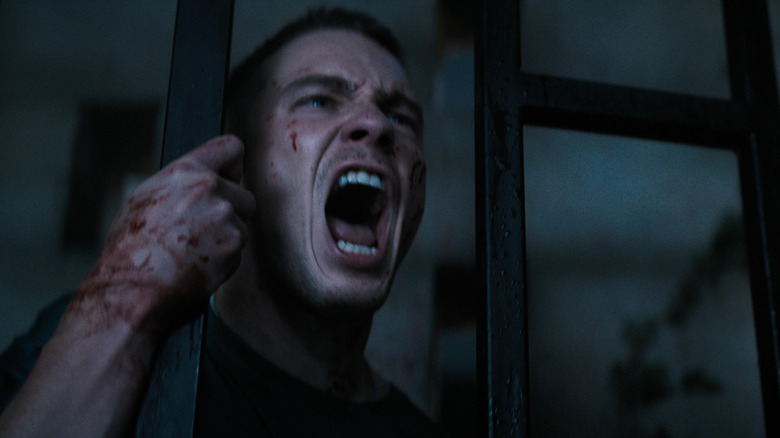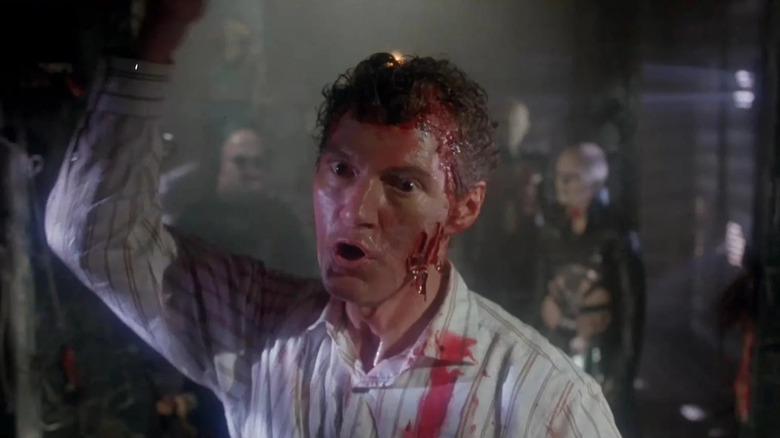Hellraiser Director David Bruckner Shares One Of His Favorite Easter Eggs From The 2022 Version
This post contains minor spoilers for the new "Hellraiser."
David Bruckner's new film "Hellraiser," the eleventh film in the series, is a proper reboot. It takes iconography and certain key elements of Clive Barker's 1987 original, and flips them into something new but recognizable. The film still centers on a mysterious puzzle box — the Lament Configuration — that, when solved, summons Cenobites, a nasty cadre of sadomasochists from beyond the grave. The function of the box, however, is now more similar to what one might have seen in the 1987 TV series "Friday the 13th: The Series." In this version, the box can also grant wishes, but only in exchange for a blood sacrifice.
Some of the similarities that Bruckner's new film has to previous installments in the "Hallraiser" film series are, of course, evident. Most notably, the signature monster is still the Lead Cenobite — nicknamed "Pinhead" since 1988, now going by Barker's preferred title of "Hell Priest" — whose skull is decorated by a grid of cuts and carefully placed nails. None of the other characters from the series (Uncle Frank, the wicked stepmother Julia, the heroine Kirsty, the evil Dr. Chanard, the toymaker Philippe Lemarchand, Adam Scott) appear in his film, however.
/Film's own Rafael Motamayor recently interviewed Brucker, and he pointed out to audiences a very particular visual reference to Barker's 1987 film that audiences might have missed. Notably, it's in the way his film's lead character Riley (Odessa A'zion) solves the Lament Configuration.
The sexuality of Hellraiser
In both 1987's "Hellraiser" and Barker's 1986 novella "The Hellbound Heart" on which it was based, the Lament Configuration is a tool that curious souls use to deliberately summon the Cenobites. In their original iteration, the Cenobites were supernaturally enhanced S&M enthusiasts whose expertise was blending pain and pleasure. They had reached a plane of sexual sensory overload so extreme, they lost their human identity. People who opened the box were, in fact, seeking a new kind of extreme sexual gratification to be found in eternal torture.
That was the case of Frank (Sean Chapman with skin, Oliver Smith without), a gruff hedonist whose sexual explorations required a little extra push. At the beginning of "Hellraiser," Frank, nude and kneeling and surrounded by candles, solves the Lament Configuration with sweaty eagerness. When hooked chains magically reach out from the darkness and puncture his skin, he immediately sees he got more than he bargained for. He is ripped apart and whisked away to Hell by the Cenobites. It won't be until his brother accidentally bleeds on the floor where he died that Frank will be able to return to Earth (albeit without skin and most of his organs).
It was the way Frank solved the Lament Configuration that Bruckner was thinking of when he filmed his lead character Riley solving it for herself. He said:
"One of my favorite [references is] that there is some direct sexual references to how the Box is handled in the original film by Frank before he's taken by the Cenobites. And we did nod to that from Riley's perspective. So there's some interaction that she has with the Box that feels like an appropriate counterpoint to that."
The sensation of Hellraiser
The new "Hellraiser," it should be noted, has less of a sexual bent than Barker's horny, horny original. The 1987 "Hellraiser" is pointedly about lust. The new "Hellraiser" frames Riley's obsession with the Lament Configuration as being linked to her former substance addiction and trauma over having lost her brother. Her need to solve the Box reveals how easily she falls into dangerous behavior patterns. Her sexuality is never connected to the Cenobites.
The Cenobites, led by a nail-festooned Jamie Clayton, are now even more elaborately mutilated than ever before. They have back muscles peeled out and wrapped across their faces. Their skin is separated from their muscle tissue, held open by wires and pins. Strips of skin are splayed open, held aloft by elaborate metal frameworks bolted into their abdomens. They wear no clothes, so the full extent of their mutilation can be seen on full display. While there is a sexual element to the Cenobites, their mutilation is staged as merely "sensation." They live in a life of extreme pain because there is something spiritually cathartic about existing in such a state. By the end of the film, they do, however, use the word "domination."
With the sexual element removed, the new "Hellraiser" has a decidedly different theme than its forebear. The Cenobites, however, are no less disturbing for the change.
"Hellraiser" is now streaming on Hulu.


